Innovation & Commercialization in Retail: Sainsbury's & ASDA
VerifiedAdded on 2023/06/11
|11
|4905
|104
Report
AI Summary
This report provides an analysis of innovation and commercialization strategies employed by Sainsbury's and ASDA, two multinational retailers. It examines how innovation is sourced and fostered within these organizations, detailing specific methods such as leading from the front, creating a culture of innovation, building effective teams, and benchmarking against competitors. The report also discusses the types of innovation used, including process, position, paradigm, and product innovation, and evaluates the success of these innovations in each retailer. Sainsbury's success with new product flavors and ASDA's expansion into online business are highlighted as examples of effective innovation and commercialization strategies. The analysis includes the four steps of the innovation process: ideation, project selection, product development, and commercialization, providing a comprehensive overview of how these retailers drive innovation and achieve commercial success.
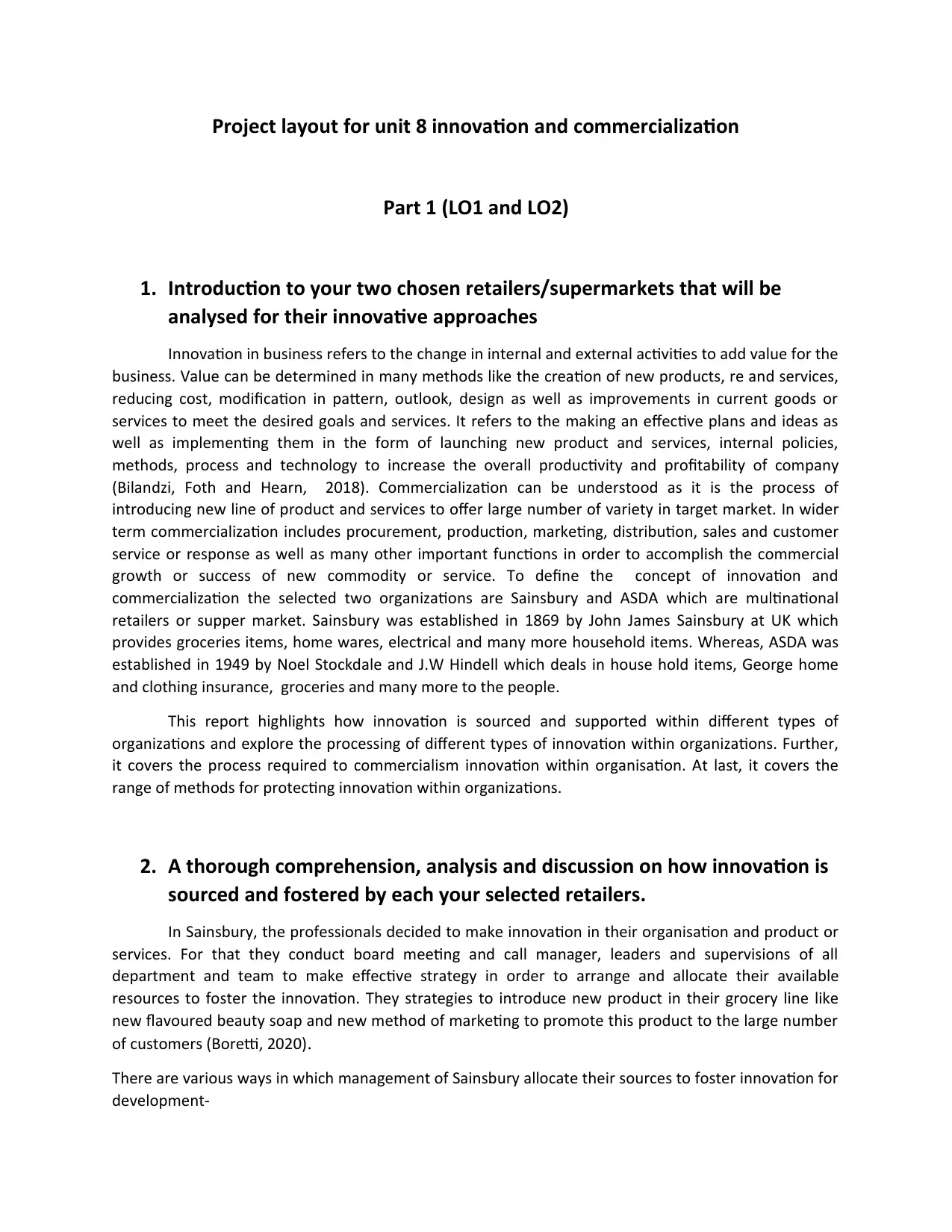
Project layout for unit 8 innovation and commercialization
Part 1 (LO1 and LO2)
1. Introduction to your two chosen retailers/supermarkets that will be
analysed for their innovative approaches
Innovation in business refers to the change in internal and external activities to add value for the
business. Value can be determined in many methods like the creation of new products, re and services,
reducing cost, modification in pattern, outlook, design as well as improvements in current goods or
services to meet the desired goals and services. It refers to the making an effective plans and ideas as
well as implementing them in the form of launching new product and services, internal policies,
methods, process and technology to increase the overall productivity and profitability of company
(Bilandzi, Foth and Hearn, 2018). Commercialization can be understood as it is the process of
introducing new line of product and services to offer large number of variety in target market. In wider
term commercialization includes procurement, production, marketing, distribution, sales and customer
service or response as well as many other important functions in order to accomplish the commercial
growth or success of new commodity or service. To define the concept of innovation and
commercialization the selected two organizations are Sainsbury and ASDA which are multinational
retailers or supper market. Sainsbury was established in 1869 by John James Sainsbury at UK which
provides groceries items, home wares, electrical and many more household items. Whereas, ASDA was
established in 1949 by Noel Stockdale and J.W Hindell which deals in house hold items, George home
and clothing insurance, groceries and many more to the people.
This report highlights how innovation is sourced and supported within different types of
organizations and explore the processing of different types of innovation within organizations. Further,
it covers the process required to commercialism innovation within organisation. At last, it covers the
range of methods for protecting innovation within organizations.
2. A thorough comprehension, analysis and discussion on how innovation is
sourced and fostered by each your selected retailers.
In Sainsbury, the professionals decided to make innovation in their organisation and product or
services. For that they conduct board meeting and call manager, leaders and supervisions of all
department and team to make effective strategy in order to arrange and allocate their available
resources to foster the innovation. They strategies to introduce new product in their grocery line like
new flavoured beauty soap and new method of marketing to promote this product to the large number
of customers (Boretti, 2020).
There are various ways in which management of Sainsbury allocate their sources to foster innovation for
development-
Part 1 (LO1 and LO2)
1. Introduction to your two chosen retailers/supermarkets that will be
analysed for their innovative approaches
Innovation in business refers to the change in internal and external activities to add value for the
business. Value can be determined in many methods like the creation of new products, re and services,
reducing cost, modification in pattern, outlook, design as well as improvements in current goods or
services to meet the desired goals and services. It refers to the making an effective plans and ideas as
well as implementing them in the form of launching new product and services, internal policies,
methods, process and technology to increase the overall productivity and profitability of company
(Bilandzi, Foth and Hearn, 2018). Commercialization can be understood as it is the process of
introducing new line of product and services to offer large number of variety in target market. In wider
term commercialization includes procurement, production, marketing, distribution, sales and customer
service or response as well as many other important functions in order to accomplish the commercial
growth or success of new commodity or service. To define the concept of innovation and
commercialization the selected two organizations are Sainsbury and ASDA which are multinational
retailers or supper market. Sainsbury was established in 1869 by John James Sainsbury at UK which
provides groceries items, home wares, electrical and many more household items. Whereas, ASDA was
established in 1949 by Noel Stockdale and J.W Hindell which deals in house hold items, George home
and clothing insurance, groceries and many more to the people.
This report highlights how innovation is sourced and supported within different types of
organizations and explore the processing of different types of innovation within organizations. Further,
it covers the process required to commercialism innovation within organisation. At last, it covers the
range of methods for protecting innovation within organizations.
2. A thorough comprehension, analysis and discussion on how innovation is
sourced and fostered by each your selected retailers.
In Sainsbury, the professionals decided to make innovation in their organisation and product or
services. For that they conduct board meeting and call manager, leaders and supervisions of all
department and team to make effective strategy in order to arrange and allocate their available
resources to foster the innovation. They strategies to introduce new product in their grocery line like
new flavoured beauty soap and new method of marketing to promote this product to the large number
of customers (Boretti, 2020).
There are various ways in which management of Sainsbury allocate their sources to foster innovation for
development-
Secure Best Marks with AI Grader
Need help grading? Try our AI Grader for instant feedback on your assignments.
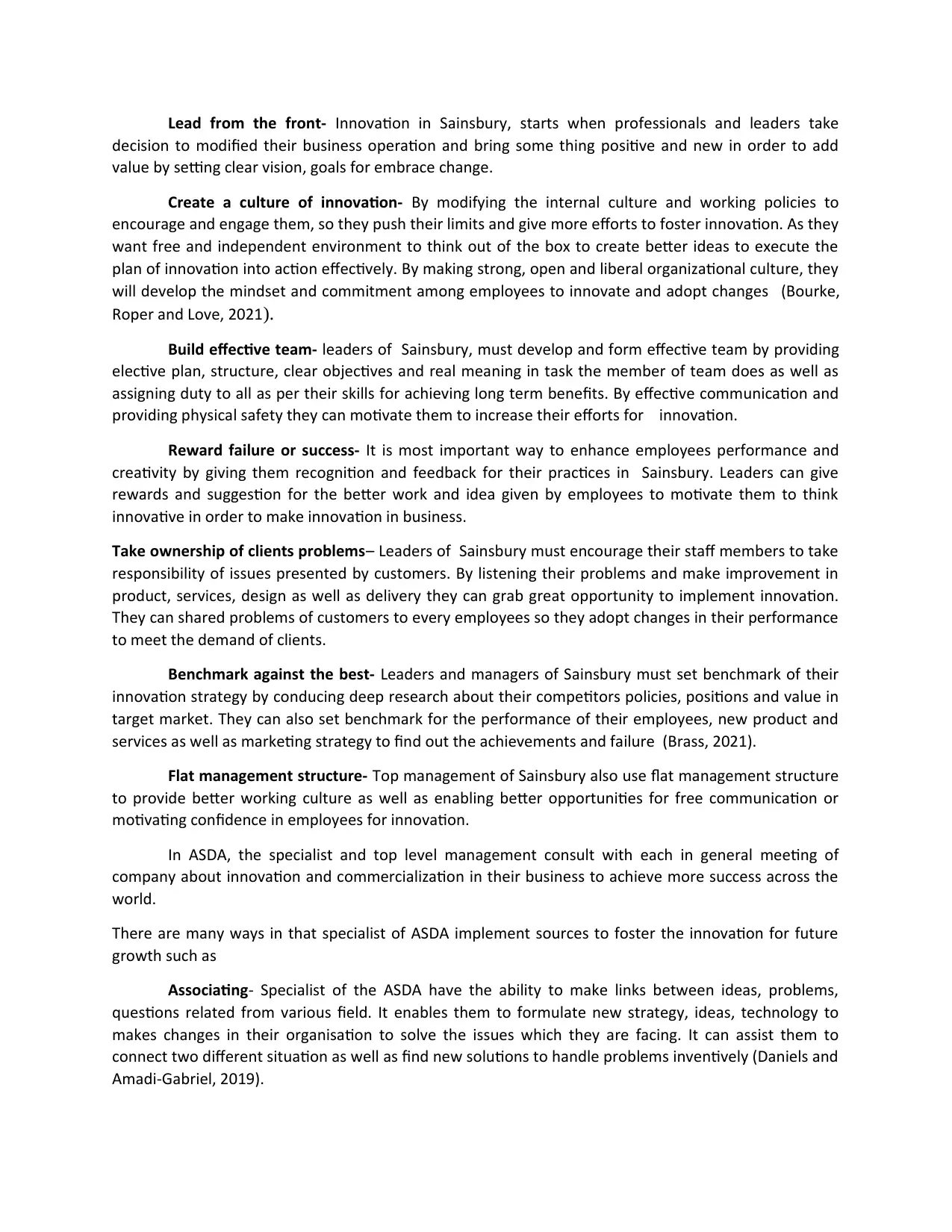
Lead from the front- Innovation in Sainsbury, starts when professionals and leaders take
decision to modified their business operation and bring some thing positive and new in order to add
value by setting clear vision, goals for embrace change.
Create a culture of innovation- By modifying the internal culture and working policies to
encourage and engage them, so they push their limits and give more efforts to foster innovation. As they
want free and independent environment to think out of the box to create better ideas to execute the
plan of innovation into action effectively. By making strong, open and liberal organizational culture, they
will develop the mindset and commitment among employees to innovate and adopt changes (Bourke,
Roper and Love, 2021).
Build effective team- leaders of Sainsbury, must develop and form effective team by providing
elective plan, structure, clear objectives and real meaning in task the member of team does as well as
assigning duty to all as per their skills for achieving long term benefits. By effective communication and
providing physical safety they can motivate them to increase their efforts for innovation.
Reward failure or success- It is most important way to enhance employees performance and
creativity by giving them recognition and feedback for their practices in Sainsbury. Leaders can give
rewards and suggestion for the better work and idea given by employees to motivate them to think
innovative in order to make innovation in business.
Take ownership of clients problems– Leaders of Sainsbury must encourage their staff members to take
responsibility of issues presented by customers. By listening their problems and make improvement in
product, services, design as well as delivery they can grab great opportunity to implement innovation.
They can shared problems of customers to every employees so they adopt changes in their performance
to meet the demand of clients.
Benchmark against the best- Leaders and managers of Sainsbury must set benchmark of their
innovation strategy by conducing deep research about their competitors policies, positions and value in
target market. They can also set benchmark for the performance of their employees, new product and
services as well as marketing strategy to find out the achievements and failure (Brass, 2021).
Flat management structure- Top management of Sainsbury also use flat management structure
to provide better working culture as well as enabling better opportunities for free communication or
motivating confidence in employees for innovation.
In ASDA, the specialist and top level management consult with each in general meeting of
company about innovation and commercialization in their business to achieve more success across the
world.
There are many ways in that specialist of ASDA implement sources to foster the innovation for future
growth such as
Associating- Specialist of the ASDA have the ability to make links between ideas, problems,
questions related from various field. It enables them to formulate new strategy, ideas, technology to
makes changes in their organisation to solve the issues which they are facing. It can assist them to
connect two different situation as well as find new solutions to handle problems inventively (Daniels and
Amadi-Gabriel, 2019).
decision to modified their business operation and bring some thing positive and new in order to add
value by setting clear vision, goals for embrace change.
Create a culture of innovation- By modifying the internal culture and working policies to
encourage and engage them, so they push their limits and give more efforts to foster innovation. As they
want free and independent environment to think out of the box to create better ideas to execute the
plan of innovation into action effectively. By making strong, open and liberal organizational culture, they
will develop the mindset and commitment among employees to innovate and adopt changes (Bourke,
Roper and Love, 2021).
Build effective team- leaders of Sainsbury, must develop and form effective team by providing
elective plan, structure, clear objectives and real meaning in task the member of team does as well as
assigning duty to all as per their skills for achieving long term benefits. By effective communication and
providing physical safety they can motivate them to increase their efforts for innovation.
Reward failure or success- It is most important way to enhance employees performance and
creativity by giving them recognition and feedback for their practices in Sainsbury. Leaders can give
rewards and suggestion for the better work and idea given by employees to motivate them to think
innovative in order to make innovation in business.
Take ownership of clients problems– Leaders of Sainsbury must encourage their staff members to take
responsibility of issues presented by customers. By listening their problems and make improvement in
product, services, design as well as delivery they can grab great opportunity to implement innovation.
They can shared problems of customers to every employees so they adopt changes in their performance
to meet the demand of clients.
Benchmark against the best- Leaders and managers of Sainsbury must set benchmark of their
innovation strategy by conducing deep research about their competitors policies, positions and value in
target market. They can also set benchmark for the performance of their employees, new product and
services as well as marketing strategy to find out the achievements and failure (Brass, 2021).
Flat management structure- Top management of Sainsbury also use flat management structure
to provide better working culture as well as enabling better opportunities for free communication or
motivating confidence in employees for innovation.
In ASDA, the specialist and top level management consult with each in general meeting of
company about innovation and commercialization in their business to achieve more success across the
world.
There are many ways in that specialist of ASDA implement sources to foster the innovation for future
growth such as
Associating- Specialist of the ASDA have the ability to make links between ideas, problems,
questions related from various field. It enables them to formulate new strategy, ideas, technology to
makes changes in their organisation to solve the issues which they are facing. It can assist them to
connect two different situation as well as find new solutions to handle problems inventively (Daniels and
Amadi-Gabriel, 2019).
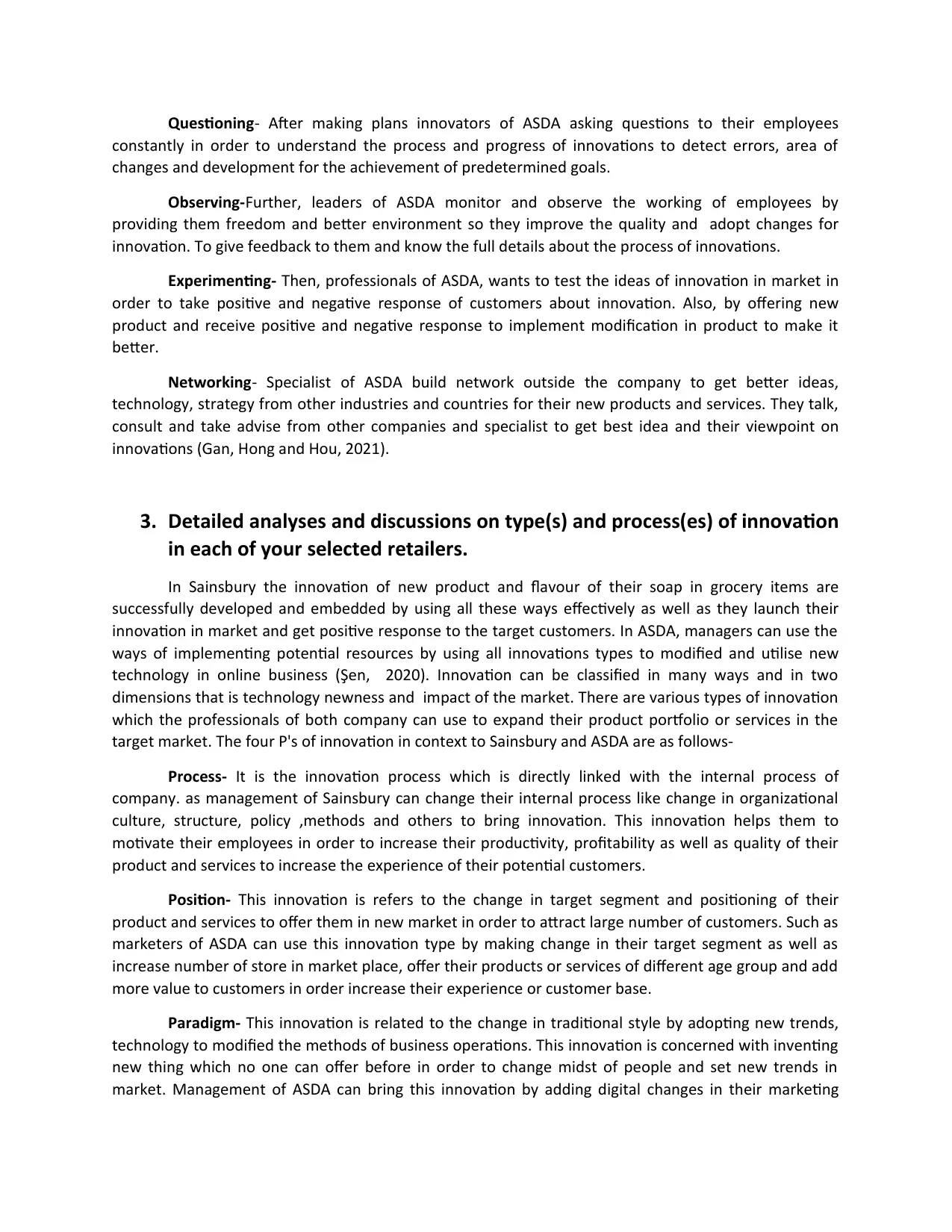
Questioning- After making plans innovators of ASDA asking questions to their employees
constantly in order to understand the process and progress of innovations to detect errors, area of
changes and development for the achievement of predetermined goals.
Observing-Further, leaders of ASDA monitor and observe the working of employees by
providing them freedom and better environment so they improve the quality and adopt changes for
innovation. To give feedback to them and know the full details about the process of innovations.
Experimenting- Then, professionals of ASDA, wants to test the ideas of innovation in market in
order to take positive and negative response of customers about innovation. Also, by offering new
product and receive positive and negative response to implement modification in product to make it
better.
Networking- Specialist of ASDA build network outside the company to get better ideas,
technology, strategy from other industries and countries for their new products and services. They talk,
consult and take advise from other companies and specialist to get best idea and their viewpoint on
innovations (Gan, Hong and Hou, 2021).
3. Detailed analyses and discussions on type(s) and process(es) of innovation
in each of your selected retailers.
In Sainsbury the innovation of new product and flavour of their soap in grocery items are
successfully developed and embedded by using all these ways effectively as well as they launch their
innovation in market and get positive response to the target customers. In ASDA, managers can use the
ways of implementing potential resources by using all innovations types to modified and utilise new
technology in online business (Şen, 2020). Innovation can be classified in many ways and in two
dimensions that is technology newness and impact of the market. There are various types of innovation
which the professionals of both company can use to expand their product portfolio or services in the
target market. The four P's of innovation in context to Sainsbury and ASDA are as follows-
Process- It is the innovation process which is directly linked with the internal process of
company. as management of Sainsbury can change their internal process like change in organizational
culture, structure, policy ,methods and others to bring innovation. This innovation helps them to
motivate their employees in order to increase their productivity, profitability as well as quality of their
product and services to increase the experience of their potential customers.
Position- This innovation is refers to the change in target segment and positioning of their
product and services to offer them in new market in order to attract large number of customers. Such as
marketers of ASDA can use this innovation type by making change in their target segment as well as
increase number of store in market place, offer their products or services of different age group and add
more value to customers in order increase their experience or customer base.
Paradigm- This innovation is related to the change in traditional style by adopting new trends,
technology to modified the methods of business operations. This innovation is concerned with inventing
new thing which no one can offer before in order to change midst of people and set new trends in
market. Management of ASDA can bring this innovation by adding digital changes in their marketing
constantly in order to understand the process and progress of innovations to detect errors, area of
changes and development for the achievement of predetermined goals.
Observing-Further, leaders of ASDA monitor and observe the working of employees by
providing them freedom and better environment so they improve the quality and adopt changes for
innovation. To give feedback to them and know the full details about the process of innovations.
Experimenting- Then, professionals of ASDA, wants to test the ideas of innovation in market in
order to take positive and negative response of customers about innovation. Also, by offering new
product and receive positive and negative response to implement modification in product to make it
better.
Networking- Specialist of ASDA build network outside the company to get better ideas,
technology, strategy from other industries and countries for their new products and services. They talk,
consult and take advise from other companies and specialist to get best idea and their viewpoint on
innovations (Gan, Hong and Hou, 2021).
3. Detailed analyses and discussions on type(s) and process(es) of innovation
in each of your selected retailers.
In Sainsbury the innovation of new product and flavour of their soap in grocery items are
successfully developed and embedded by using all these ways effectively as well as they launch their
innovation in market and get positive response to the target customers. In ASDA, managers can use the
ways of implementing potential resources by using all innovations types to modified and utilise new
technology in online business (Şen, 2020). Innovation can be classified in many ways and in two
dimensions that is technology newness and impact of the market. There are various types of innovation
which the professionals of both company can use to expand their product portfolio or services in the
target market. The four P's of innovation in context to Sainsbury and ASDA are as follows-
Process- It is the innovation process which is directly linked with the internal process of
company. as management of Sainsbury can change their internal process like change in organizational
culture, structure, policy ,methods and others to bring innovation. This innovation helps them to
motivate their employees in order to increase their productivity, profitability as well as quality of their
product and services to increase the experience of their potential customers.
Position- This innovation is refers to the change in target segment and positioning of their
product and services to offer them in new market in order to attract large number of customers. Such as
marketers of ASDA can use this innovation type by making change in their target segment as well as
increase number of store in market place, offer their products or services of different age group and add
more value to customers in order increase their experience or customer base.
Paradigm- This innovation is related to the change in traditional style by adopting new trends,
technology to modified the methods of business operations. This innovation is concerned with inventing
new thing which no one can offer before in order to change midst of people and set new trends in
market. Management of ASDA can bring this innovation by adding digital changes in their marketing
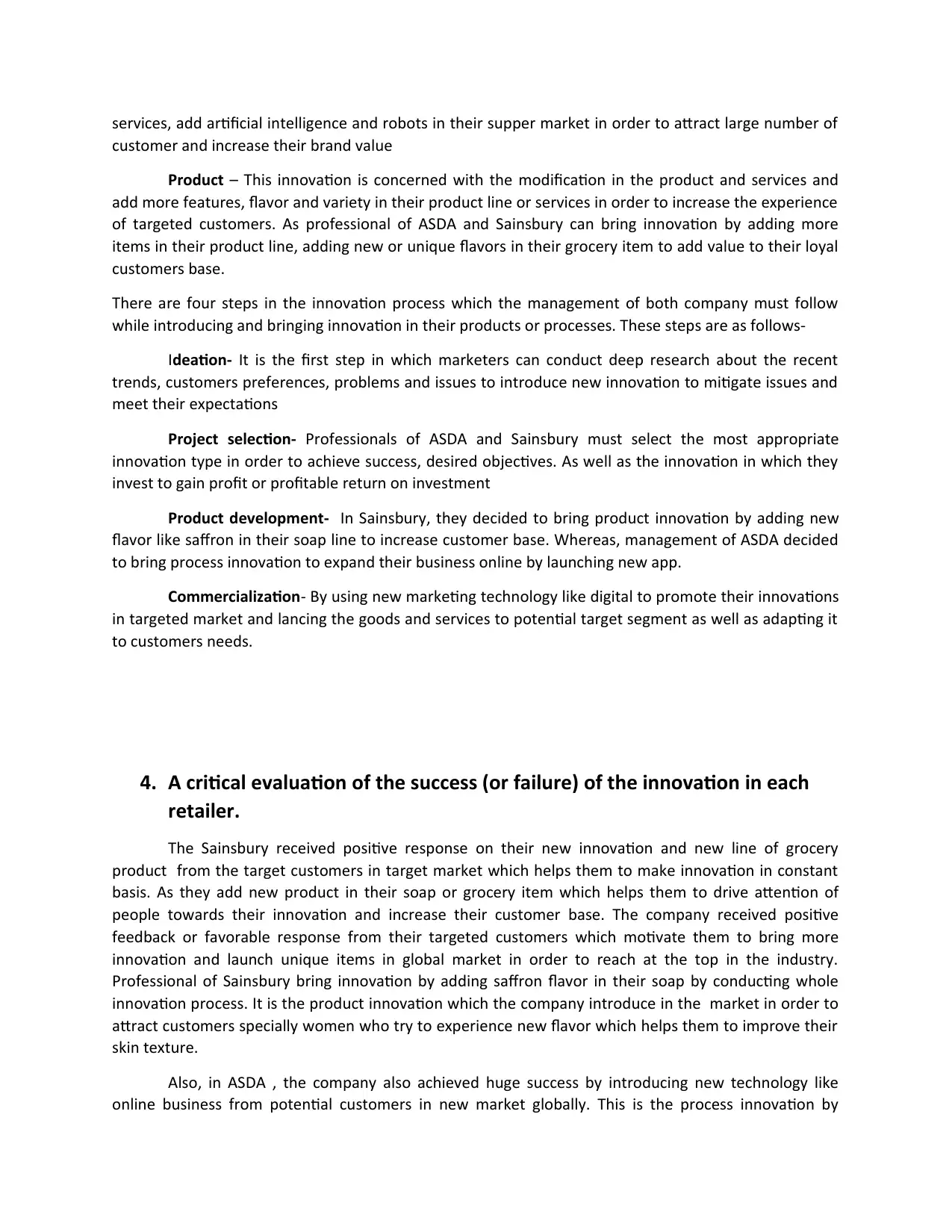
services, add artificial intelligence and robots in their supper market in order to attract large number of
customer and increase their brand value
Product – This innovation is concerned with the modification in the product and services and
add more features, flavor and variety in their product line or services in order to increase the experience
of targeted customers. As professional of ASDA and Sainsbury can bring innovation by adding more
items in their product line, adding new or unique flavors in their grocery item to add value to their loyal
customers base.
There are four steps in the innovation process which the management of both company must follow
while introducing and bringing innovation in their products or processes. These steps are as follows-
Ideation- It is the first step in which marketers can conduct deep research about the recent
trends, customers preferences, problems and issues to introduce new innovation to mitigate issues and
meet their expectations
Project selection- Professionals of ASDA and Sainsbury must select the most appropriate
innovation type in order to achieve success, desired objectives. As well as the innovation in which they
invest to gain profit or profitable return on investment
Product development- In Sainsbury, they decided to bring product innovation by adding new
flavor like saffron in their soap line to increase customer base. Whereas, management of ASDA decided
to bring process innovation to expand their business online by launching new app.
Commercialization- By using new marketing technology like digital to promote their innovations
in targeted market and lancing the goods and services to potential target segment as well as adapting it
to customers needs.
4. A critical evaluation of the success (or failure) of the innovation in each
retailer.
The Sainsbury received positive response on their new innovation and new line of grocery
product from the target customers in target market which helps them to make innovation in constant
basis. As they add new product in their soap or grocery item which helps them to drive attention of
people towards their innovation and increase their customer base. The company received positive
feedback or favorable response from their targeted customers which motivate them to bring more
innovation and launch unique items in global market in order to reach at the top in the industry.
Professional of Sainsbury bring innovation by adding saffron flavor in their soap by conducting whole
innovation process. It is the product innovation which the company introduce in the market in order to
attract customers specially women who try to experience new flavor which helps them to improve their
skin texture.
Also, in ASDA , the company also achieved huge success by introducing new technology like
online business from potential customers in new market globally. This is the process innovation by
customer and increase their brand value
Product – This innovation is concerned with the modification in the product and services and
add more features, flavor and variety in their product line or services in order to increase the experience
of targeted customers. As professional of ASDA and Sainsbury can bring innovation by adding more
items in their product line, adding new or unique flavors in their grocery item to add value to their loyal
customers base.
There are four steps in the innovation process which the management of both company must follow
while introducing and bringing innovation in their products or processes. These steps are as follows-
Ideation- It is the first step in which marketers can conduct deep research about the recent
trends, customers preferences, problems and issues to introduce new innovation to mitigate issues and
meet their expectations
Project selection- Professionals of ASDA and Sainsbury must select the most appropriate
innovation type in order to achieve success, desired objectives. As well as the innovation in which they
invest to gain profit or profitable return on investment
Product development- In Sainsbury, they decided to bring product innovation by adding new
flavor like saffron in their soap line to increase customer base. Whereas, management of ASDA decided
to bring process innovation to expand their business online by launching new app.
Commercialization- By using new marketing technology like digital to promote their innovations
in targeted market and lancing the goods and services to potential target segment as well as adapting it
to customers needs.
4. A critical evaluation of the success (or failure) of the innovation in each
retailer.
The Sainsbury received positive response on their new innovation and new line of grocery
product from the target customers in target market which helps them to make innovation in constant
basis. As they add new product in their soap or grocery item which helps them to drive attention of
people towards their innovation and increase their customer base. The company received positive
feedback or favorable response from their targeted customers which motivate them to bring more
innovation and launch unique items in global market in order to reach at the top in the industry.
Professional of Sainsbury bring innovation by adding saffron flavor in their soap by conducting whole
innovation process. It is the product innovation which the company introduce in the market in order to
attract customers specially women who try to experience new flavor which helps them to improve their
skin texture.
Also, in ASDA , the company also achieved huge success by introducing new technology like
online business from potential customers in new market globally. This is the process innovation by
Secure Best Marks with AI Grader
Need help grading? Try our AI Grader for instant feedback on your assignments.
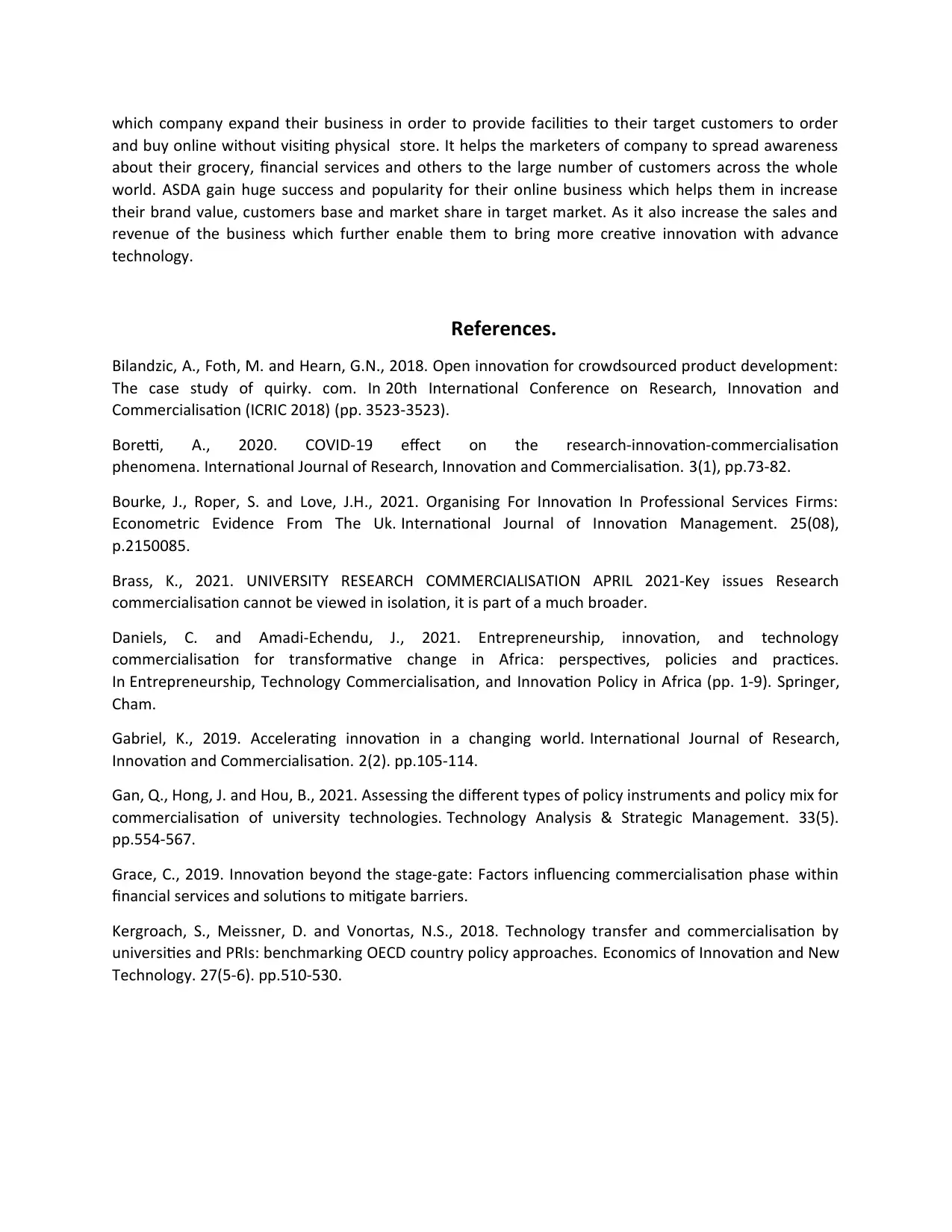
which company expand their business in order to provide facilities to their target customers to order
and buy online without visiting physical store. It helps the marketers of company to spread awareness
about their grocery, financial services and others to the large number of customers across the whole
world. ASDA gain huge success and popularity for their online business which helps them in increase
their brand value, customers base and market share in target market. As it also increase the sales and
revenue of the business which further enable them to bring more creative innovation with advance
technology.
References.
Bilandzic, A., Foth, M. and Hearn, G.N., 2018. Open innovation for crowdsourced product development:
The case study of quirky. com. In 20th International Conference on Research, Innovation and
Commercialisation (ICRIC 2018) (pp. 3523-3523).
Boretti, A., 2020. COVID-19 effect on the research-innovation-commercialisation
phenomena. International Journal of Research, Innovation and Commercialisation. 3(1), pp.73-82.
Bourke, J., Roper, S. and Love, J.H., 2021. Organising For Innovation In Professional Services Firms:
Econometric Evidence From The Uk. International Journal of Innovation Management. 25(08),
p.2150085.
Brass, K., 2021. UNIVERSITY RESEARCH COMMERCIALISATION APRIL 2021-Key issues Research
commercialisation cannot be viewed in isolation, it is part of a much broader.
Daniels, C. and Amadi-Echendu, J., 2021. Entrepreneurship, innovation, and technology
commercialisation for transformative change in Africa: perspectives, policies and practices.
In Entrepreneurship, Technology Commercialisation, and Innovation Policy in Africa (pp. 1-9). Springer,
Cham.
Gabriel, K., 2019. Accelerating innovation in a changing world. International Journal of Research,
Innovation and Commercialisation. 2(2). pp.105-114.
Gan, Q., Hong, J. and Hou, B., 2021. Assessing the different types of policy instruments and policy mix for
commercialisation of university technologies. Technology Analysis & Strategic Management. 33(5).
pp.554-567.
Grace, C., 2019. Innovation beyond the stage-gate: Factors influencing commercialisation phase within
financial services and solutions to mitigate barriers.
Kergroach, S., Meissner, D. and Vonortas, N.S., 2018. Technology transfer and commercialisation by
universities and PRIs: benchmarking OECD country policy approaches. Economics of Innovation and New
Technology. 27(5-6). pp.510-530.
and buy online without visiting physical store. It helps the marketers of company to spread awareness
about their grocery, financial services and others to the large number of customers across the whole
world. ASDA gain huge success and popularity for their online business which helps them in increase
their brand value, customers base and market share in target market. As it also increase the sales and
revenue of the business which further enable them to bring more creative innovation with advance
technology.
References.
Bilandzic, A., Foth, M. and Hearn, G.N., 2018. Open innovation for crowdsourced product development:
The case study of quirky. com. In 20th International Conference on Research, Innovation and
Commercialisation (ICRIC 2018) (pp. 3523-3523).
Boretti, A., 2020. COVID-19 effect on the research-innovation-commercialisation
phenomena. International Journal of Research, Innovation and Commercialisation. 3(1), pp.73-82.
Bourke, J., Roper, S. and Love, J.H., 2021. Organising For Innovation In Professional Services Firms:
Econometric Evidence From The Uk. International Journal of Innovation Management. 25(08),
p.2150085.
Brass, K., 2021. UNIVERSITY RESEARCH COMMERCIALISATION APRIL 2021-Key issues Research
commercialisation cannot be viewed in isolation, it is part of a much broader.
Daniels, C. and Amadi-Echendu, J., 2021. Entrepreneurship, innovation, and technology
commercialisation for transformative change in Africa: perspectives, policies and practices.
In Entrepreneurship, Technology Commercialisation, and Innovation Policy in Africa (pp. 1-9). Springer,
Cham.
Gabriel, K., 2019. Accelerating innovation in a changing world. International Journal of Research,
Innovation and Commercialisation. 2(2). pp.105-114.
Gan, Q., Hong, J. and Hou, B., 2021. Assessing the different types of policy instruments and policy mix for
commercialisation of university technologies. Technology Analysis & Strategic Management. 33(5).
pp.554-567.
Grace, C., 2019. Innovation beyond the stage-gate: Factors influencing commercialisation phase within
financial services and solutions to mitigate barriers.
Kergroach, S., Meissner, D. and Vonortas, N.S., 2018. Technology transfer and commercialisation by
universities and PRIs: benchmarking OECD country policy approaches. Economics of Innovation and New
Technology. 27(5-6). pp.510-530.
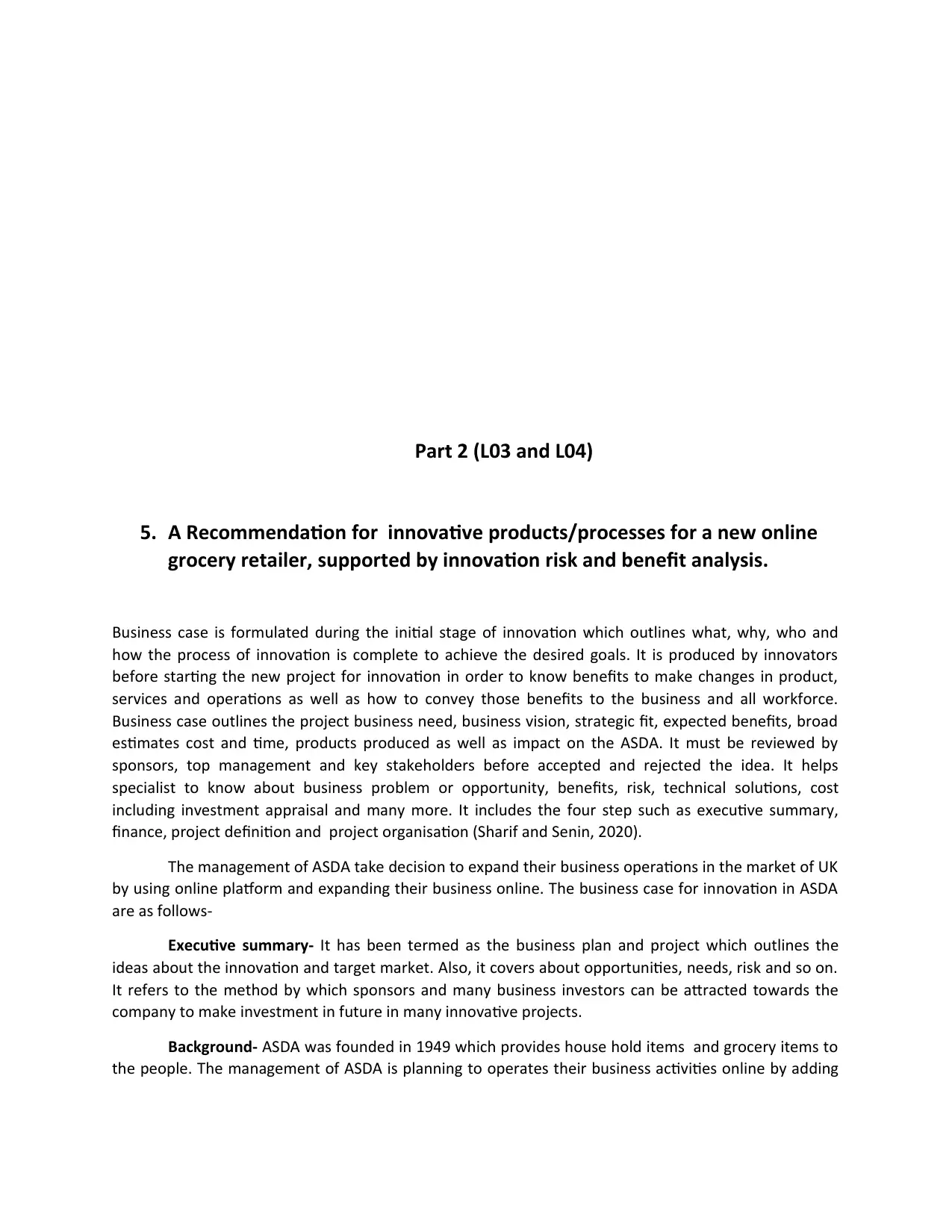
Part 2 (L03 and L04)
5. A Recommendation for innovative products/processes for a new online
grocery retailer, supported by innovation risk and benefit analysis.
Business case is formulated during the initial stage of innovation which outlines what, why, who and
how the process of innovation is complete to achieve the desired goals. It is produced by innovators
before starting the new project for innovation in order to know benefits to make changes in product,
services and operations as well as how to convey those benefits to the business and all workforce.
Business case outlines the project business need, business vision, strategic fit, expected benefits, broad
estimates cost and time, products produced as well as impact on the ASDA. It must be reviewed by
sponsors, top management and key stakeholders before accepted and rejected the idea. It helps
specialist to know about business problem or opportunity, benefits, risk, technical solutions, cost
including investment appraisal and many more. It includes the four step such as executive summary,
finance, project definition and project organisation (Sharif and Senin, 2020).
The management of ASDA take decision to expand their business operations in the market of UK
by using online platform and expanding their business online. The business case for innovation in ASDA
are as follows-
Executive summary- It has been termed as the business plan and project which outlines the
ideas about the innovation and target market. Also, it covers about opportunities, needs, risk and so on.
It refers to the method by which sponsors and many business investors can be attracted towards the
company to make investment in future in many innovative projects.
Background- ASDA was founded in 1949 which provides house hold items and grocery items to
the people. The management of ASDA is planning to operates their business activities online by adding
5. A Recommendation for innovative products/processes for a new online
grocery retailer, supported by innovation risk and benefit analysis.
Business case is formulated during the initial stage of innovation which outlines what, why, who and
how the process of innovation is complete to achieve the desired goals. It is produced by innovators
before starting the new project for innovation in order to know benefits to make changes in product,
services and operations as well as how to convey those benefits to the business and all workforce.
Business case outlines the project business need, business vision, strategic fit, expected benefits, broad
estimates cost and time, products produced as well as impact on the ASDA. It must be reviewed by
sponsors, top management and key stakeholders before accepted and rejected the idea. It helps
specialist to know about business problem or opportunity, benefits, risk, technical solutions, cost
including investment appraisal and many more. It includes the four step such as executive summary,
finance, project definition and project organisation (Sharif and Senin, 2020).
The management of ASDA take decision to expand their business operations in the market of UK
by using online platform and expanding their business online. The business case for innovation in ASDA
are as follows-
Executive summary- It has been termed as the business plan and project which outlines the
ideas about the innovation and target market. Also, it covers about opportunities, needs, risk and so on.
It refers to the method by which sponsors and many business investors can be attracted towards the
company to make investment in future in many innovative projects.
Background- ASDA was founded in 1949 which provides house hold items and grocery items to
the people. The management of ASDA is planning to operates their business activities online by adding
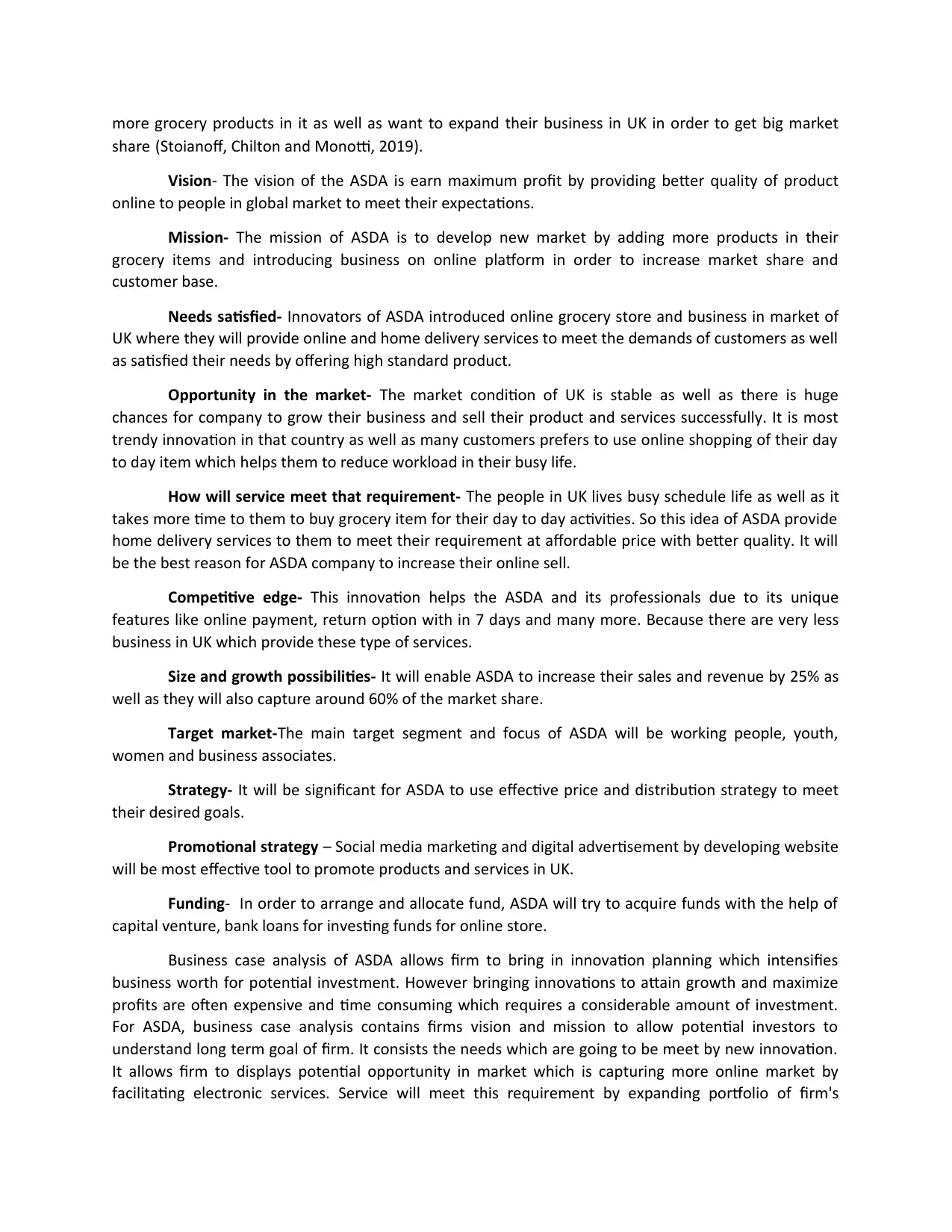
more grocery products in it as well as want to expand their business in UK in order to get big market
share (Stoianoff, Chilton and Monotti, 2019).
Vision- The vision of the ASDA is earn maximum profit by providing better quality of product
online to people in global market to meet their expectations.
Mission- The mission of ASDA is to develop new market by adding more products in their
grocery items and introducing business on online platform in order to increase market share and
customer base.
Needs satisfied- Innovators of ASDA introduced online grocery store and business in market of
UK where they will provide online and home delivery services to meet the demands of customers as well
as satisfied their needs by offering high standard product.
Opportunity in the market- The market condition of UK is stable as well as there is huge
chances for company to grow their business and sell their product and services successfully. It is most
trendy innovation in that country as well as many customers prefers to use online shopping of their day
to day item which helps them to reduce workload in their busy life.
How will service meet that requirement- The people in UK lives busy schedule life as well as it
takes more time to them to buy grocery item for their day to day activities. So this idea of ASDA provide
home delivery services to them to meet their requirement at affordable price with better quality. It will
be the best reason for ASDA company to increase their online sell.
Competitive edge- This innovation helps the ASDA and its professionals due to its unique
features like online payment, return option with in 7 days and many more. Because there are very less
business in UK which provide these type of services.
Size and growth possibilities- It will enable ASDA to increase their sales and revenue by 25% as
well as they will also capture around 60% of the market share.
Target market-The main target segment and focus of ASDA will be working people, youth,
women and business associates.
Strategy- It will be significant for ASDA to use effective price and distribution strategy to meet
their desired goals.
Promotional strategy – Social media marketing and digital advertisement by developing website
will be most effective tool to promote products and services in UK.
Funding- In order to arrange and allocate fund, ASDA will try to acquire funds with the help of
capital venture, bank loans for investing funds for online store.
Business case analysis of ASDA allows firm to bring in innovation planning which intensifies
business worth for potential investment. However bringing innovations to attain growth and maximize
profits are often expensive and time consuming which requires a considerable amount of investment.
For ASDA, business case analysis contains firms vision and mission to allow potential investors to
understand long term goal of firm. It consists the needs which are going to be meet by new innovation.
It allows firm to displays potential opportunity in market which is capturing more online market by
facilitating electronic services. Service will meet this requirement by expanding portfolio of firm's
share (Stoianoff, Chilton and Monotti, 2019).
Vision- The vision of the ASDA is earn maximum profit by providing better quality of product
online to people in global market to meet their expectations.
Mission- The mission of ASDA is to develop new market by adding more products in their
grocery items and introducing business on online platform in order to increase market share and
customer base.
Needs satisfied- Innovators of ASDA introduced online grocery store and business in market of
UK where they will provide online and home delivery services to meet the demands of customers as well
as satisfied their needs by offering high standard product.
Opportunity in the market- The market condition of UK is stable as well as there is huge
chances for company to grow their business and sell their product and services successfully. It is most
trendy innovation in that country as well as many customers prefers to use online shopping of their day
to day item which helps them to reduce workload in their busy life.
How will service meet that requirement- The people in UK lives busy schedule life as well as it
takes more time to them to buy grocery item for their day to day activities. So this idea of ASDA provide
home delivery services to them to meet their requirement at affordable price with better quality. It will
be the best reason for ASDA company to increase their online sell.
Competitive edge- This innovation helps the ASDA and its professionals due to its unique
features like online payment, return option with in 7 days and many more. Because there are very less
business in UK which provide these type of services.
Size and growth possibilities- It will enable ASDA to increase their sales and revenue by 25% as
well as they will also capture around 60% of the market share.
Target market-The main target segment and focus of ASDA will be working people, youth,
women and business associates.
Strategy- It will be significant for ASDA to use effective price and distribution strategy to meet
their desired goals.
Promotional strategy – Social media marketing and digital advertisement by developing website
will be most effective tool to promote products and services in UK.
Funding- In order to arrange and allocate fund, ASDA will try to acquire funds with the help of
capital venture, bank loans for investing funds for online store.
Business case analysis of ASDA allows firm to bring in innovation planning which intensifies
business worth for potential investment. However bringing innovations to attain growth and maximize
profits are often expensive and time consuming which requires a considerable amount of investment.
For ASDA, business case analysis contains firms vision and mission to allow potential investors to
understand long term goal of firm. It consists the needs which are going to be meet by new innovation.
It allows firm to displays potential opportunity in market which is capturing more online market by
facilitating electronic services. Service will meet this requirement by expanding portfolio of firm's
Paraphrase This Document
Need a fresh take? Get an instant paraphrase of this document with our AI Paraphraser
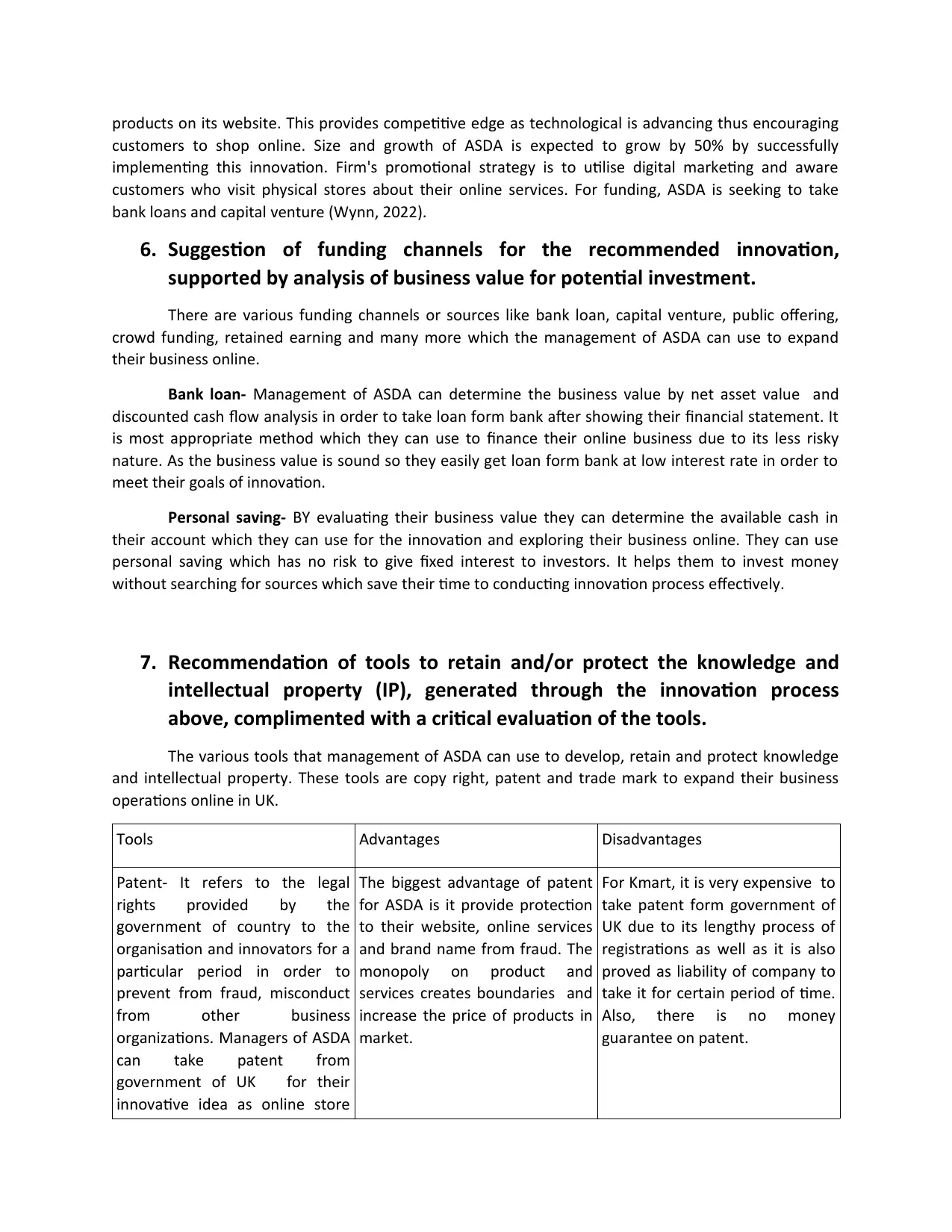
products on its website. This provides competitive edge as technological is advancing thus encouraging
customers to shop online. Size and growth of ASDA is expected to grow by 50% by successfully
implementing this innovation. Firm's promotional strategy is to utilise digital marketing and aware
customers who visit physical stores about their online services. For funding, ASDA is seeking to take
bank loans and capital venture (Wynn, 2022).
6. Suggestion of funding channels for the recommended innovation,
supported by analysis of business value for potential investment.
There are various funding channels or sources like bank loan, capital venture, public offering,
crowd funding, retained earning and many more which the management of ASDA can use to expand
their business online.
Bank loan- Management of ASDA can determine the business value by net asset value and
discounted cash flow analysis in order to take loan form bank after showing their financial statement. It
is most appropriate method which they can use to finance their online business due to its less risky
nature. As the business value is sound so they easily get loan form bank at low interest rate in order to
meet their goals of innovation.
Personal saving- BY evaluating their business value they can determine the available cash in
their account which they can use for the innovation and exploring their business online. They can use
personal saving which has no risk to give fixed interest to investors. It helps them to invest money
without searching for sources which save their time to conducting innovation process effectively.
7. Recommendation of tools to retain and/or protect the knowledge and
intellectual property (IP), generated through the innovation process
above, complimented with a critical evaluation of the tools.
The various tools that management of ASDA can use to develop, retain and protect knowledge
and intellectual property. These tools are copy right, patent and trade mark to expand their business
operations online in UK.
Tools Advantages Disadvantages
Patent- It refers to the legal
rights provided by the
government of country to the
organisation and innovators for a
particular period in order to
prevent from fraud, misconduct
from other business
organizations. Managers of ASDA
can take patent from
government of UK for their
innovative idea as online store
The biggest advantage of patent
for ASDA is it provide protection
to their website, online services
and brand name from fraud. The
monopoly on product and
services creates boundaries and
increase the price of products in
market.
For Kmart, it is very expensive to
take patent form government of
UK due to its lengthy process of
registrations as well as it is also
proved as liability of company to
take it for certain period of time.
Also, there is no money
guarantee on patent.
customers to shop online. Size and growth of ASDA is expected to grow by 50% by successfully
implementing this innovation. Firm's promotional strategy is to utilise digital marketing and aware
customers who visit physical stores about their online services. For funding, ASDA is seeking to take
bank loans and capital venture (Wynn, 2022).
6. Suggestion of funding channels for the recommended innovation,
supported by analysis of business value for potential investment.
There are various funding channels or sources like bank loan, capital venture, public offering,
crowd funding, retained earning and many more which the management of ASDA can use to expand
their business online.
Bank loan- Management of ASDA can determine the business value by net asset value and
discounted cash flow analysis in order to take loan form bank after showing their financial statement. It
is most appropriate method which they can use to finance their online business due to its less risky
nature. As the business value is sound so they easily get loan form bank at low interest rate in order to
meet their goals of innovation.
Personal saving- BY evaluating their business value they can determine the available cash in
their account which they can use for the innovation and exploring their business online. They can use
personal saving which has no risk to give fixed interest to investors. It helps them to invest money
without searching for sources which save their time to conducting innovation process effectively.
7. Recommendation of tools to retain and/or protect the knowledge and
intellectual property (IP), generated through the innovation process
above, complimented with a critical evaluation of the tools.
The various tools that management of ASDA can use to develop, retain and protect knowledge
and intellectual property. These tools are copy right, patent and trade mark to expand their business
operations online in UK.
Tools Advantages Disadvantages
Patent- It refers to the legal
rights provided by the
government of country to the
organisation and innovators for a
particular period in order to
prevent from fraud, misconduct
from other business
organizations. Managers of ASDA
can take patent from
government of UK for their
innovative idea as online store
The biggest advantage of patent
for ASDA is it provide protection
to their website, online services
and brand name from fraud. The
monopoly on product and
services creates boundaries and
increase the price of products in
market.
For Kmart, it is very expensive to
take patent form government of
UK due to its lengthy process of
registrations as well as it is also
proved as liability of company to
take it for certain period of time.
Also, there is no money
guarantee on patent.
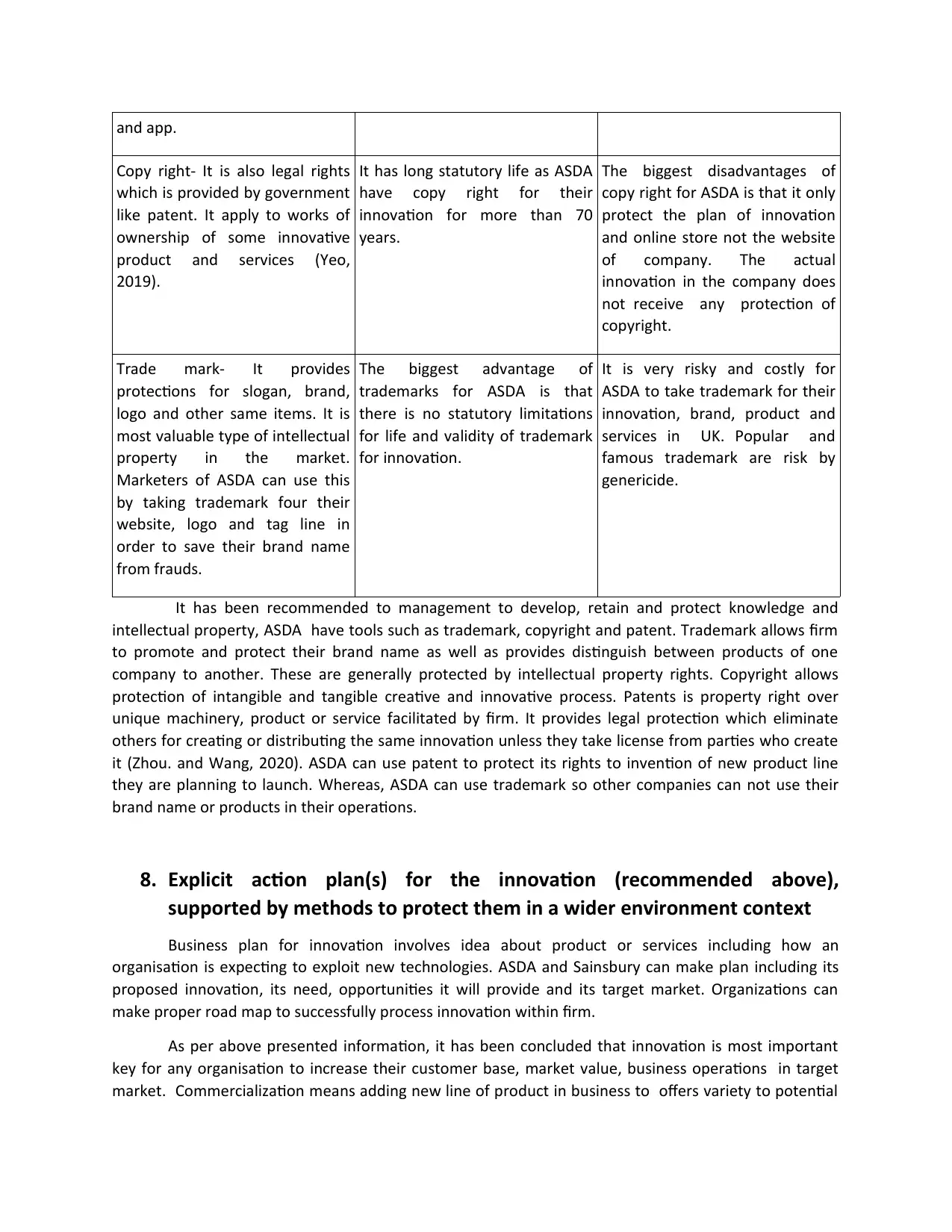
and app.
Copy right- It is also legal rights
which is provided by government
like patent. It apply to works of
ownership of some innovative
product and services (Yeo,
2019).
It has long statutory life as ASDA
have copy right for their
innovation for more than 70
years.
The biggest disadvantages of
copy right for ASDA is that it only
protect the plan of innovation
and online store not the website
of company. The actual
innovation in the company does
not receive any protection of
copyright.
Trade mark- It provides
protections for slogan, brand,
logo and other same items. It is
most valuable type of intellectual
property in the market.
Marketers of ASDA can use this
by taking trademark four their
website, logo and tag line in
order to save their brand name
from frauds.
The biggest advantage of
trademarks for ASDA is that
there is no statutory limitations
for life and validity of trademark
for innovation.
It is very risky and costly for
ASDA to take trademark for their
innovation, brand, product and
services in UK. Popular and
famous trademark are risk by
genericide.
It has been recommended to management to develop, retain and protect knowledge and
intellectual property, ASDA have tools such as trademark, copyright and patent. Trademark allows firm
to promote and protect their brand name as well as provides distinguish between products of one
company to another. These are generally protected by intellectual property rights. Copyright allows
protection of intangible and tangible creative and innovative process. Patents is property right over
unique machinery, product or service facilitated by firm. It provides legal protection which eliminate
others for creating or distributing the same innovation unless they take license from parties who create
it (Zhou. and Wang, 2020). ASDA can use patent to protect its rights to invention of new product line
they are planning to launch. Whereas, ASDA can use trademark so other companies can not use their
brand name or products in their operations.
8. Explicit action plan(s) for the innovation (recommended above),
supported by methods to protect them in a wider environment context
Business plan for innovation involves idea about product or services including how an
organisation is expecting to exploit new technologies. ASDA and Sainsbury can make plan including its
proposed innovation, its need, opportunities it will provide and its target market. Organizations can
make proper road map to successfully process innovation within firm.
As per above presented information, it has been concluded that innovation is most important
key for any organisation to increase their customer base, market value, business operations in target
market. Commercialization means adding new line of product in business to offers variety to potential
Copy right- It is also legal rights
which is provided by government
like patent. It apply to works of
ownership of some innovative
product and services (Yeo,
2019).
It has long statutory life as ASDA
have copy right for their
innovation for more than 70
years.
The biggest disadvantages of
copy right for ASDA is that it only
protect the plan of innovation
and online store not the website
of company. The actual
innovation in the company does
not receive any protection of
copyright.
Trade mark- It provides
protections for slogan, brand,
logo and other same items. It is
most valuable type of intellectual
property in the market.
Marketers of ASDA can use this
by taking trademark four their
website, logo and tag line in
order to save their brand name
from frauds.
The biggest advantage of
trademarks for ASDA is that
there is no statutory limitations
for life and validity of trademark
for innovation.
It is very risky and costly for
ASDA to take trademark for their
innovation, brand, product and
services in UK. Popular and
famous trademark are risk by
genericide.
It has been recommended to management to develop, retain and protect knowledge and
intellectual property, ASDA have tools such as trademark, copyright and patent. Trademark allows firm
to promote and protect their brand name as well as provides distinguish between products of one
company to another. These are generally protected by intellectual property rights. Copyright allows
protection of intangible and tangible creative and innovative process. Patents is property right over
unique machinery, product or service facilitated by firm. It provides legal protection which eliminate
others for creating or distributing the same innovation unless they take license from parties who create
it (Zhou. and Wang, 2020). ASDA can use patent to protect its rights to invention of new product line
they are planning to launch. Whereas, ASDA can use trademark so other companies can not use their
brand name or products in their operations.
8. Explicit action plan(s) for the innovation (recommended above),
supported by methods to protect them in a wider environment context
Business plan for innovation involves idea about product or services including how an
organisation is expecting to exploit new technologies. ASDA and Sainsbury can make plan including its
proposed innovation, its need, opportunities it will provide and its target market. Organizations can
make proper road map to successfully process innovation within firm.
As per above presented information, it has been concluded that innovation is most important
key for any organisation to increase their customer base, market value, business operations in target
market. Commercialization means adding new line of product in business to offers variety to potential
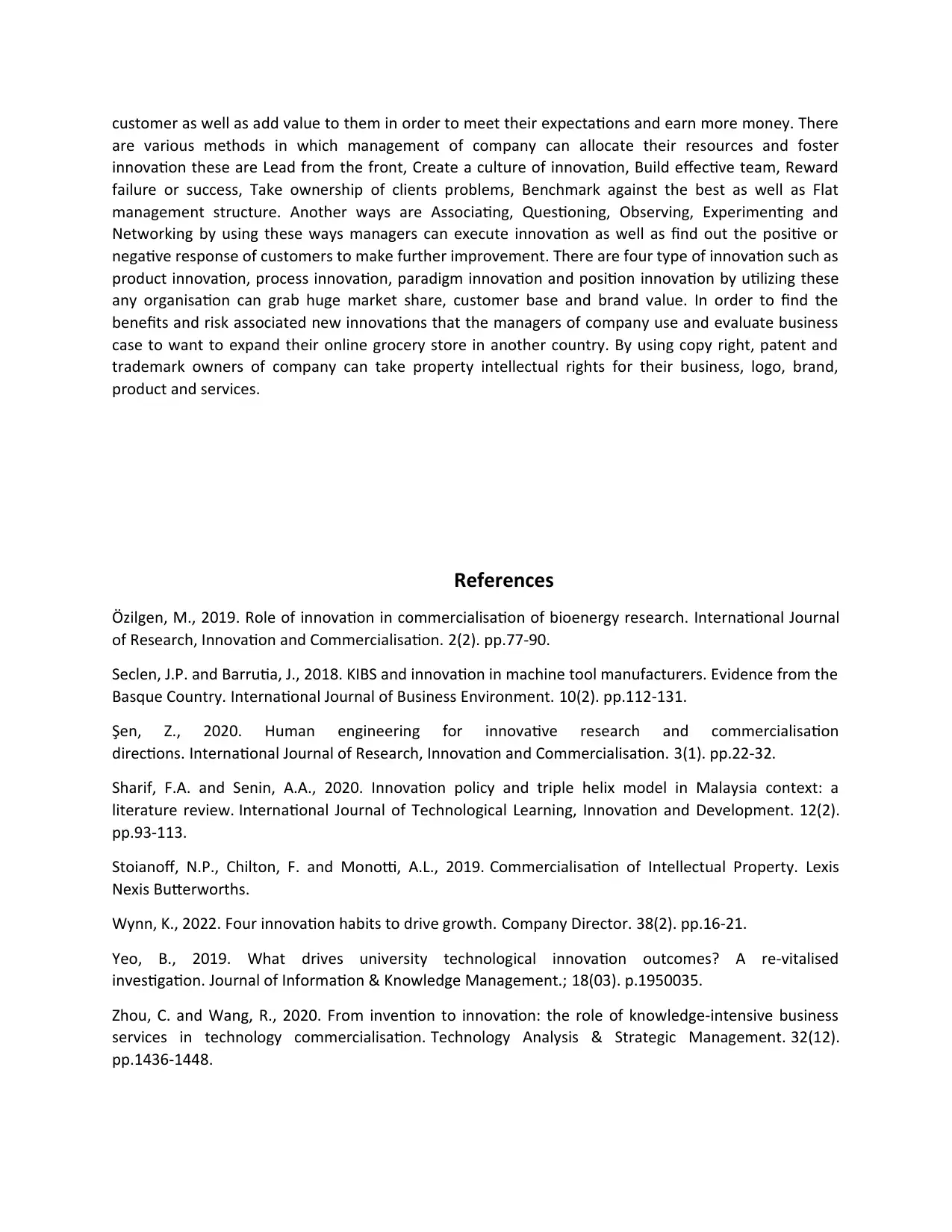
customer as well as add value to them in order to meet their expectations and earn more money. There
are various methods in which management of company can allocate their resources and foster
innovation these are Lead from the front, Create a culture of innovation, Build effective team, Reward
failure or success, Take ownership of clients problems, Benchmark against the best as well as Flat
management structure. Another ways are Associating, Questioning, Observing, Experimenting and
Networking by using these ways managers can execute innovation as well as find out the positive or
negative response of customers to make further improvement. There are four type of innovation such as
product innovation, process innovation, paradigm innovation and position innovation by utilizing these
any organisation can grab huge market share, customer base and brand value. In order to find the
benefits and risk associated new innovations that the managers of company use and evaluate business
case to want to expand their online grocery store in another country. By using copy right, patent and
trademark owners of company can take property intellectual rights for their business, logo, brand,
product and services.
References
Özilgen, M., 2019. Role of innovation in commercialisation of bioenergy research. International Journal
of Research, Innovation and Commercialisation. 2(2). pp.77-90.
Seclen, J.P. and Barrutia, J., 2018. KIBS and innovation in machine tool manufacturers. Evidence from the
Basque Country. International Journal of Business Environment. 10(2). pp.112-131.
Şen, Z., 2020. Human engineering for innovative research and commercialisation
directions. International Journal of Research, Innovation and Commercialisation. 3(1). pp.22-32.
Sharif, F.A. and Senin, A.A., 2020. Innovation policy and triple helix model in Malaysia context: a
literature review. International Journal of Technological Learning, Innovation and Development. 12(2).
pp.93-113.
Stoianoff, N.P., Chilton, F. and Monotti, A.L., 2019. Commercialisation of Intellectual Property. Lexis
Nexis Butterworths.
Wynn, K., 2022. Four innovation habits to drive growth. Company Director. 38(2). pp.16-21.
Yeo, B., 2019. What drives university technological innovation outcomes? A re-vitalised
investigation. Journal of Information & Knowledge Management.; 18(03). p.1950035.
Zhou, C. and Wang, R., 2020. From invention to innovation: the role of knowledge-intensive business
services in technology commercialisation. Technology Analysis & Strategic Management. 32(12).
pp.1436-1448.
are various methods in which management of company can allocate their resources and foster
innovation these are Lead from the front, Create a culture of innovation, Build effective team, Reward
failure or success, Take ownership of clients problems, Benchmark against the best as well as Flat
management structure. Another ways are Associating, Questioning, Observing, Experimenting and
Networking by using these ways managers can execute innovation as well as find out the positive or
negative response of customers to make further improvement. There are four type of innovation such as
product innovation, process innovation, paradigm innovation and position innovation by utilizing these
any organisation can grab huge market share, customer base and brand value. In order to find the
benefits and risk associated new innovations that the managers of company use and evaluate business
case to want to expand their online grocery store in another country. By using copy right, patent and
trademark owners of company can take property intellectual rights for their business, logo, brand,
product and services.
References
Özilgen, M., 2019. Role of innovation in commercialisation of bioenergy research. International Journal
of Research, Innovation and Commercialisation. 2(2). pp.77-90.
Seclen, J.P. and Barrutia, J., 2018. KIBS and innovation in machine tool manufacturers. Evidence from the
Basque Country. International Journal of Business Environment. 10(2). pp.112-131.
Şen, Z., 2020. Human engineering for innovative research and commercialisation
directions. International Journal of Research, Innovation and Commercialisation. 3(1). pp.22-32.
Sharif, F.A. and Senin, A.A., 2020. Innovation policy and triple helix model in Malaysia context: a
literature review. International Journal of Technological Learning, Innovation and Development. 12(2).
pp.93-113.
Stoianoff, N.P., Chilton, F. and Monotti, A.L., 2019. Commercialisation of Intellectual Property. Lexis
Nexis Butterworths.
Wynn, K., 2022. Four innovation habits to drive growth. Company Director. 38(2). pp.16-21.
Yeo, B., 2019. What drives university technological innovation outcomes? A re-vitalised
investigation. Journal of Information & Knowledge Management.; 18(03). p.1950035.
Zhou, C. and Wang, R., 2020. From invention to innovation: the role of knowledge-intensive business
services in technology commercialisation. Technology Analysis & Strategic Management. 32(12).
pp.1436-1448.
Secure Best Marks with AI Grader
Need help grading? Try our AI Grader for instant feedback on your assignments.

1 out of 11
Related Documents
Your All-in-One AI-Powered Toolkit for Academic Success.
+13062052269
info@desklib.com
Available 24*7 on WhatsApp / Email
![[object Object]](/_next/static/media/star-bottom.7253800d.svg)
Unlock your academic potential
© 2024 | Zucol Services PVT LTD | All rights reserved.



